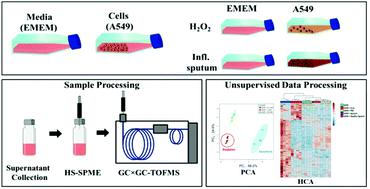Our official English website, www.x-mol.net, welcomes your
feedback! (Note: you will need to create a separate account there.)
Comparison of the effect of chemically and biologically induced inflammation on the volatile metabolite production of lung epithelial cells by GC×GC-TOFMS.
Analyst ( IF 3.6 ) Pub Date : 2020-06-29 , DOI: 10.1039/d0an00720j Delphine Zanella 1 , Monique Henket , Florence Schleich , Thibaut Dejong , Renaud Louis , Jean-François Focant , Pierre-Hugues Stefanuto
Analyst ( IF 3.6 ) Pub Date : 2020-06-29 , DOI: 10.1039/d0an00720j Delphine Zanella 1 , Monique Henket , Florence Schleich , Thibaut Dejong , Renaud Louis , Jean-François Focant , Pierre-Hugues Stefanuto
Affiliation

|
Exhaled breath analysis has a high potential for early non-invasive diagnosis of lung inflammatory diseases, such as asthma. The characterization and understanding of the inflammatory metabolic pathways involved into volatile organic compounds (VOCs) production could bring exhaled breath analysis into clinical practice and thus open new therapeutic routes for inflammatory diseases. In this study, lung inflammation was simulated in vitro using A549 epithelial cells. We compared the VOC production from A549 epithelial cells after a chemically induced oxidative stress in vitro, exposing the cells to H2O2, and a biological stress, exposing the cells to an inflammatory pool of sputum supernatants. Special attention was devoted to define proper negative and positive controls (8 different types) for our in vitro models, including healthy sputum co-culture. Sputum from 25 asthmatic and 8 healthy patients were collected to create each pool of supernatants. Each sample type was analyzed in 4 replicates using solid-phase microextraction (SPME) comprehensive two-dimensional gas chromatography hyphenated to time-of-flight mass spectrometry (GC×GC-TOFMS). This approach offers high resolving power for complex VOC mixtures. According to the type of inflammation induced, significantly different VOCs were produced by the epithelial cells compared to all controls. For both chemical and biological challenges, an increase of carbonyl compounds (54%) and hydrocarbons (31%) was observed. Interestingly, only the biological inflammation model showed a significant cell proliferation together with an increased VOC production linked to asthma airway inflammation. This study presents a complete GC×GC-TOFMS workflow for in vitro VOC analysis, and its potential to characterize complex lung inflammatory mechanisms.
中文翻译:

化学和生物诱导炎症对GC×GC-TOFMS对肺上皮细胞挥发性代谢产物产生影响的比较。
呼气分析在早期非侵入性诊断肺炎性疾病(例如哮喘)中具有很高的潜力。对挥发性有机化合物(VOC)产生中涉及的炎症代谢途径的表征和理解,可以将呼气分析纳入临床实践,从而为炎症性疾病开辟新的治疗途径。在这项研究中,使用A549上皮细胞在体外模拟了肺部炎症。我们比较了化学诱导的体外氧化应激(使细胞暴露于H 2 O 2)后A549上皮细胞的VOC产生以及生物应激,将细胞暴露于痰液上清液的炎症池中。特别注意为体外定义合适的阴性和阳性对照(8种不同类型)模型,包括健康的痰共培养。收集来自25名哮喘患者和8名健康患者的痰液,以创建每个上清液池。使用固相微萃取(SPME)综合二维气相色谱法(以飞行时间质谱(GC×GC-TOFMS)联用)对每种样品类型进行4次重复分析。这种方法为复杂的VOC混合物提供了较高的分辨能力。根据诱发的炎症类型,与所有对照相比,上皮细胞产生的挥发性有机化合物明显不同。对于化学和生物学挑战,均观察到羰基化合物(54%)和碳氢化合物(31%)的增加。有趣的是,只有生物学炎症模型显示出显着的细胞增殖以及与哮喘气道炎症相关的VOC产生增加。体外VOC分析及其表征复杂肺部炎症机制的潜力。
更新日期:2020-07-30
中文翻译:

化学和生物诱导炎症对GC×GC-TOFMS对肺上皮细胞挥发性代谢产物产生影响的比较。
呼气分析在早期非侵入性诊断肺炎性疾病(例如哮喘)中具有很高的潜力。对挥发性有机化合物(VOC)产生中涉及的炎症代谢途径的表征和理解,可以将呼气分析纳入临床实践,从而为炎症性疾病开辟新的治疗途径。在这项研究中,使用A549上皮细胞在体外模拟了肺部炎症。我们比较了化学诱导的体外氧化应激(使细胞暴露于H 2 O 2)后A549上皮细胞的VOC产生以及生物应激,将细胞暴露于痰液上清液的炎症池中。特别注意为体外定义合适的阴性和阳性对照(8种不同类型)模型,包括健康的痰共培养。收集来自25名哮喘患者和8名健康患者的痰液,以创建每个上清液池。使用固相微萃取(SPME)综合二维气相色谱法(以飞行时间质谱(GC×GC-TOFMS)联用)对每种样品类型进行4次重复分析。这种方法为复杂的VOC混合物提供了较高的分辨能力。根据诱发的炎症类型,与所有对照相比,上皮细胞产生的挥发性有机化合物明显不同。对于化学和生物学挑战,均观察到羰基化合物(54%)和碳氢化合物(31%)的增加。有趣的是,只有生物学炎症模型显示出显着的细胞增殖以及与哮喘气道炎症相关的VOC产生增加。体外VOC分析及其表征复杂肺部炎症机制的潜力。










































 京公网安备 11010802027423号
京公网安备 11010802027423号